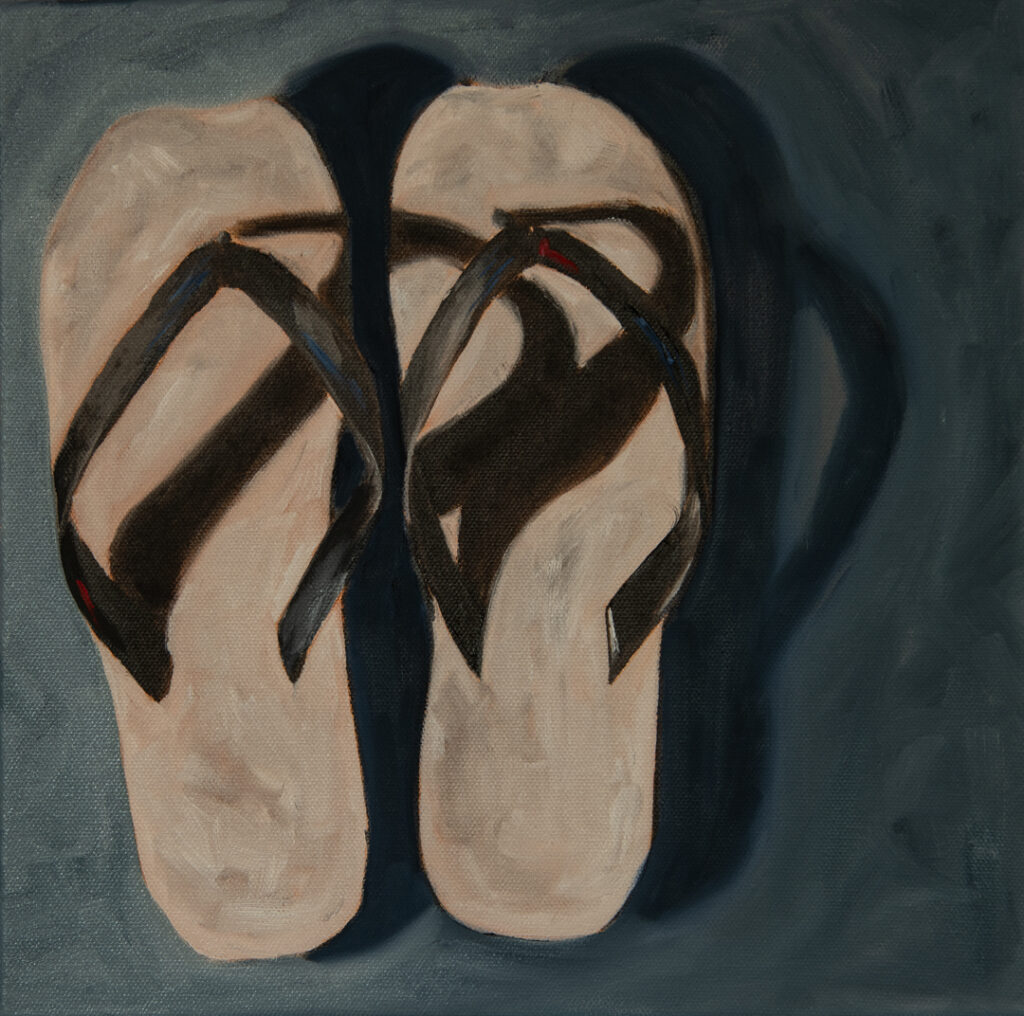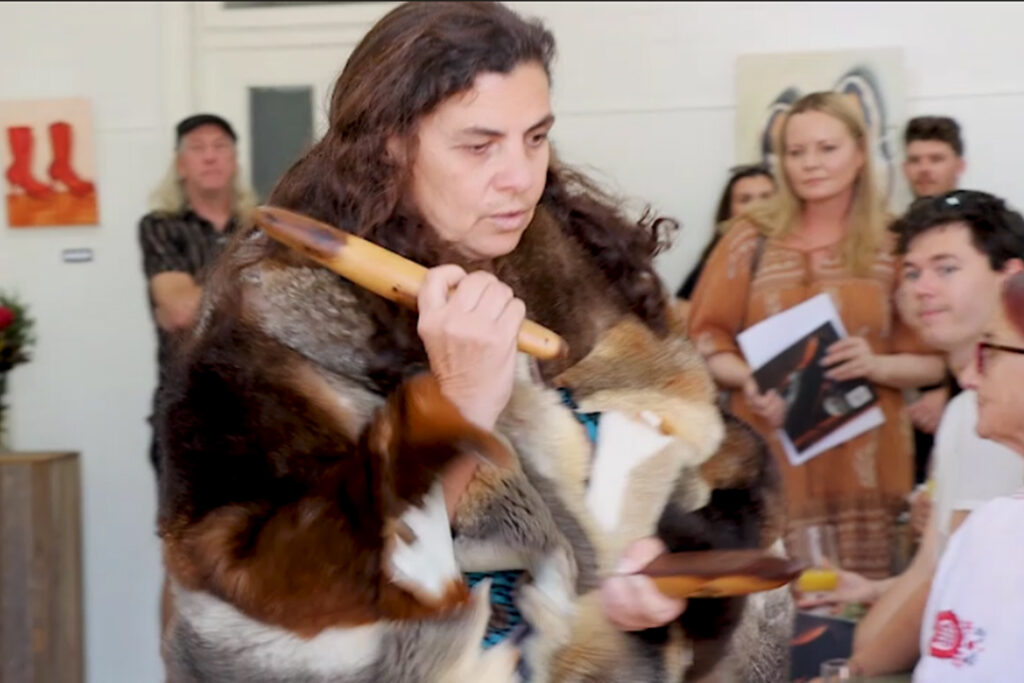Rhonda Murray gives identity to the familiar but anonymous people who populate our streets.
(A message to the reader.)
Rhonda Murray’s Walk My Way project involves a book publication about anonymous people in her hometown, along with paintings of their shoes and stories of their lives.
Murray started work as a survey draftsperson. She eventually enrolled at TAFE to apply her drawing skills more creatively. When TAFE closed down, she went across the road to Wollongong University and took up a Creative Arts degree as the only mature-age student in the class. “I had this preconceived idea that 18-year-olds hadn’t lived much, that they’re pretty shallow.” She was surprised and impressed by their life stories. That made her realise the power of sharing stories. “We all felt connected in different ways.”
While on the arts board of Kiama Council, she discussed her interest with Gail Morgan who encouraged her to apply for a grant. “I’d be happy to help you write the stories.”
The challenge was to find the people who would give her a diverse range of life stories. “Kiama is known as a white middle-class suburb. I wanted to challenge that.” Contacts appeared by word of mouth.
Murray made the decision to leave the stories nameless.
“There was one particular interview with a young girl who was sexually abused. And her court case was going to court the following year, and she knew her perpetrator. I just thought I did not want to put her name to her story. And then I thought, well if I make everyone anonymous, people might be able to step into those shoes, in a way to imagine themselves in the stories.”
She sought out “people on the fringe that are quieter, and just go about their everyday lives.” Her husband was a firefighter and good friends with a policeman. “He’s a really happy-go-lucky guy, extremely funny. But I know that he’s seen a lot of things that everyday people or you and I would never even contemplate or imagine.”
Her story was about the transformation when the policeman comes home and takes off his uniform to become a husband and father.
- Dr Jodi Edwards Welcome to Country 1, 2022
- Viewer at exhibition, 2022, photo: Rhonda Murray
Despite this anonymity, most of her subjects appeared at the launch of the exhibition of these works in the local community art centre. “I thought, Oh, I hope they don’t feel obliged to have to buy the paintings, but some of them did.”
The Man in Blue
The Man in Blue comes from good European stock. His father was born in Poland in 1923 and experienced war as a young child. He saw his four brothers shot by the Russians. His mother remarried and he grew up with new stepbrothers. Throughout World War II, his father was sent to a couple of concentration camps and was lucky to escape. He fled to Australia.
The Man in Blue’s mother grew up in the small Greek Island of Leros. When she was young, her brother moved to Australia, and she eventually followed him to settle in Wollongong.
His parents met each other and, with their thick accents and very little English between them, they somehow managed to communicate (although the Man in Blue thinks that communication was not necessarily verbal) and then married in Fairy Meadow. They eventually moved to Warilla where the Man in Blue grew up, before moving to Oak Flats.
School was tough because the Man in Blue couldn’t rely on his parents for help with schoolwork as they weren’t very educated and struggled with the English language, so a lot of his education was very much self-taught. He was very fortunate to have the support of good friends and their families to encourage him in activities and his love of sport. He remembers friends’ mothers driving him around to sporting events such as swimming, soccer and basketball. He is very grateful that he grew up in such a close-knit community.
After finishing high school, the Man in Blue applied for university to do Commerce but didn’t have the marks to be accepted. Ever since primary school he had dreamed of becoming a police officer, but his mother wouldn’t let him. He instead became a trainee manager at Woolworths but didn’t last 12 months – it was not for him. His mother eventually conceded, and the Man in Blue finally joined the police force.
After his training at Goulburn, the Man in Blue had his heart set on being sent to the Illawarra, however that was not to be. He was allocated Queanbeyan. A friend that he went through training with was from the bush, and she was allocated Redfern and was about to quit. Thinking that Queanbeyan was a little bit more country than Redfern, the two did a swap.
As a welcome to Redfern, on his first day of work the Man in Blue was driving down Everleigh Street on patrol when suddenly, a double balsa brick came flying and smashed the front windscreen of the car. He later found out that this area was a no-go zone.
In his early days in the police force, the Man in Blue was doing random breath testing on the harbour bridge, and found himself staring in awe at his surroundings, a typical country boy in the big city, only to be disturbed by his Sergeant yelling “you can tell you’re not from the city”.
After seven years at Redfern, the Man in Blue returned to the Illawarra. He eventually earned a promotion and found himself back in the city again – this time in Surry Hills. He enjoyed his time there and managed security for major sporting events, protests, and visits from world leaders. He remembers the first time the world series baseball came to Australia, as well as leading soccer teams passionately marching through the city. It was stressful but at the same time enjoyable.
The Man in Blue was eventually posted to the Southern Highlands where he met a lot of politicians and celebrities. He oversaw the community during the Bush Fires of 2019 and had to prepare people for what was coming and help people in the aftermath. He sees this as a privilege, to be able to help these people in times of crisis, and keeps in touch with some of them to this day.
The Man in Blue has now come full circle and is working in Queanbeyan. He initially went there for a six week relieving stint and, two years later, is still there. He was encouraged by his peers to apply for the position of Superintendent and got this promotion, being very grateful for the opportunity.
The Man in Blue says that, as much as the job can make you cry, it can make you laugh. There has been a huge change in support in the police force – from the early days, where you went for a beer after work to destress, to now having mental health planning in place and psychological support available. Police officers see a lot of things that the human brain cannot cope with, so the Man in Blue is fortunate to have the support of his friends and family.
For the last fifteen years the Man in Blue has been a regular at what is known as The Table of Big Ideas – a once a week (or whenever they can fit it in) meet up over coffee with like-minded friends that include a paramedic, firefighter, builder and farmer. This Table started as a casual coffee after dropping their kids off at primary school and is still going today, even though those kids are now adults.
At times, everyone has been through tough patches, with work or personal things, and the Table is a good outlet for all. Everyone has an opinion on everything, and, whilst they don’t achieve anything, they definitely come up with some great ideas that won’t change the world but might help.
The Man in Blue’s advice is to enjoy the people you work with rather than the job – if you work with good people, you can keep going. When he comes home from work, he says there is nothing better than taking off his work boots and putting his thongs on. Getting out of his work boots is symbolic of the end of work for the day and returning to his home self.
Perhaps, one day, the Man in Blue and the Table of Big Ideas will come up with a new idea for the Kiama community which may actually come to fruition!
About Rhonda Murray
 Rhonda Murray is a visual artist and printmaker living on the South Coast of New South Wales, Australia. Her work explores themes of human frailty, the internal body and the power and vitality of life, with a particular interest in the intersection of science and art. Rhonda has a Bachelor of Creative Arts (Deans Scholar) from Wollongong University and currently teaches Printmaking and Watercolours at Hazelhurst Regional Gallery. Visit www.rhondamurray.com and follow @rhonda_m_art.
Rhonda Murray is a visual artist and printmaker living on the South Coast of New South Wales, Australia. Her work explores themes of human frailty, the internal body and the power and vitality of life, with a particular interest in the intersection of science and art. Rhonda has a Bachelor of Creative Arts (Deans Scholar) from Wollongong University and currently teaches Printmaking and Watercolours at Hazelhurst Regional Gallery. Visit www.rhondamurray.com and follow @rhonda_m_art.





